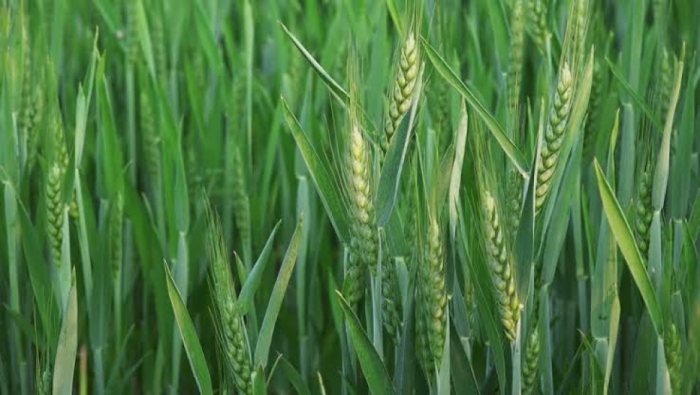
Expert's suggestions for wheat crop in December

These are the some suggestions for wheat from PAU experts:
2. (a) For the control of loose smut and flag smut in late sown wheat, treat the seed in seed treating drum with Raxil Easy/Orius 6 FS @ 13ml or Vitavax Power @ 120g or Vitavax @ 80g or Tebuseed 2DS/ Seedex 2 DS/Exzole 2 DS @ 40g per 40kg seed before sowing.
(b) Seed treatment should not be done earlier than one month of sowing as it affects seed germination. In sub-mountainous tracts of the state monitor the crop for occurrence of yellow rust infection foci and manage these by spot application of Nativo @ 0.6ml or Tilt or Shine or Bumper or Compass or Stilt or Markzole @ 1 ml in 1 litre of water.
(c) If the attack of pink stem borer appears in the crop, spray 800 ml Ekalux 25 EC (quinalphos) by dissolving in 100 liters of water per acre.
3. (a) Phalaris minor and wild oats can also be controlled by spraying isoproturon herbicide 2 to 3 days before first irrigation using 100 litrs of water. On heavy textured soil, use isoproturon 75 WP @ 500 g/acre. In case of medium textured soils, isoproturon 75 WP can be used @ 400 g/acre. In case of light textured soils, the dose can be reduced to 300 g/acre of isoproturon 75 WP.
(b) Sulfosulfuron @ 13g/ are can be sprayed before irrigation using 50 litres of water. Do not use sulfosulfuron if any broad leaf crop is sown in wheat and where jowar or maize to be sown after wheat.
(c) In case of mixed infestation of grasses and broadleaf weeds, 2, 4-D @ 250 g/acre or metasulfuron can be tank mixed with isoproturon or clodinafop 15 WP 160g/acre or Fenoxaprop-p-ethyl 10 EC 400 ml/acre or use Atlantis 3.6 WDG at 160 g or Total or Markpower 75 WG 16 g or Accord Plus 500g /acre or Shagun 21-11@ 200g/acre after first irrigation.
(d) For the control of isoproturon resistant biotypes of Phalaris in rice-wheat cropping system use Stomp/Dost/Markpendi/Penda/Pendin/ Bunker/Zokiyama 30 EC (Pendimethalin) at 1.5 litre/acre as pre-emergence by dissolving the herbicide in 200 litres of water. Alternately, use Clodinafop 15 WP @ 160 g/acre or Fenoxapropethyl 10 EC @ 400 ml/acre or Leader/SF 10/ Safal/Marksulfo 75 WG (Sulfosulfuron) @ 13 g/acre or Axial 5 EC (Pinoxaden) 400 ml/acre or Atlantis 3.6 WDG (mesosulfuron+iodosulfuron) 160 g/acre or Total/Markpower 75 WG (sulfosulfuron + metsulfuron) 16 g/acre or Accord Plus (Fenoxaprop+ Metribuzin) 500ml/acre or Shagun 21-11 @ 200g/acre. Spray either of the herbicide in 150 litres of water after 30-35 days of sowing wheat by using flat fan nozzle. Do not apply Accord Plus and Shagun 21-11 on PBW 550 and Unnat PBW 550 wheat variety. Avoid the use of Shagun 21-11 on light textured soils.
4. For control of broadleaf weeds only, use 2,4-D @ 250 g/acre at 35-45 days after sowing in case of normal sown (October-November) and 45-55 days after sowing for late sown wheat (December sown). Algrip/Agrip Royal/Markgrip 20 WP (metsulfuron) @ 10 g/acre can also be used for control of Kandia wali Palak (Jangli Palak) and other hardy broadleaf weeds by using 150 litres of water and its time of application is 30-35 days after sowing . Button weed and other broadleaf weeds can also be controlled with the application of Aim/Affinity 40 DF @ 20g/acre by dissolving in 200 litre of water at 25-30 days after sowing. For control of makoh rari/rewari, kandali palak, hirankhuri spray lanfida 50 DF @ 20g/acre in 150 litres of water at 25-30 days of sowing. Do not use 2, 4-D/ Algrip lanfida in wheat intercropped with Raya/Gobhi sarson/Gram.
5. Wheat crop sown after October should be given first irrigation after four weeks of sowing. On light textured soils, first irrigation should be advanced by one week. Apply second dose of 55 kg urea per acre with first irrigation.
6. If the wheat follows potato, which received 10 tonnes FYM per acre, no phosphorus and one half of nitrogen may be applied.
7. On light textured and kallar (reclaimed) soils, zinc deficiency is expected after application of first irrigation. The deficiency symptoms appear on third and fourth leaves from the top and the leaves become yellow in the middle, while the tip and bottom remain green. To correct zinc deficiency, broadcast 25 kg zinc sulphate (21%) per acre by mixing with the same quantity of dry soil.
8. In light textured soils, where wheat follows paddy, manganese deficiency may develop light greyish yellow to pinkish brown streaks on leaves and the veins remain green. If such deficiency symptoms are noticed, 0.5 % manganese sulphate solution i.e. 1 kg manganese sulphate in 200 litres of water per acre may be sprayed. One spray before first irrigation and two to three sprays at weekly interval after irrigation are sufficient.
9. In case of sulphur deficiency, the upper leaves become light green and later on yellow but the lower leaves remain green. If such symptoms are noticed, broadcast one quintal gypsum/acre followed by a light irrigation or if the soil is in proper moisture condition, this may be mixed by hoeing.
Expert Communities
We do not share your personal details with anyone
Sign In
Registering to this website, you accept our Terms of Use and our Privacy Policy.
Sign Up
Registering to this website, you accept our Terms of Use and our Privacy Policy.








